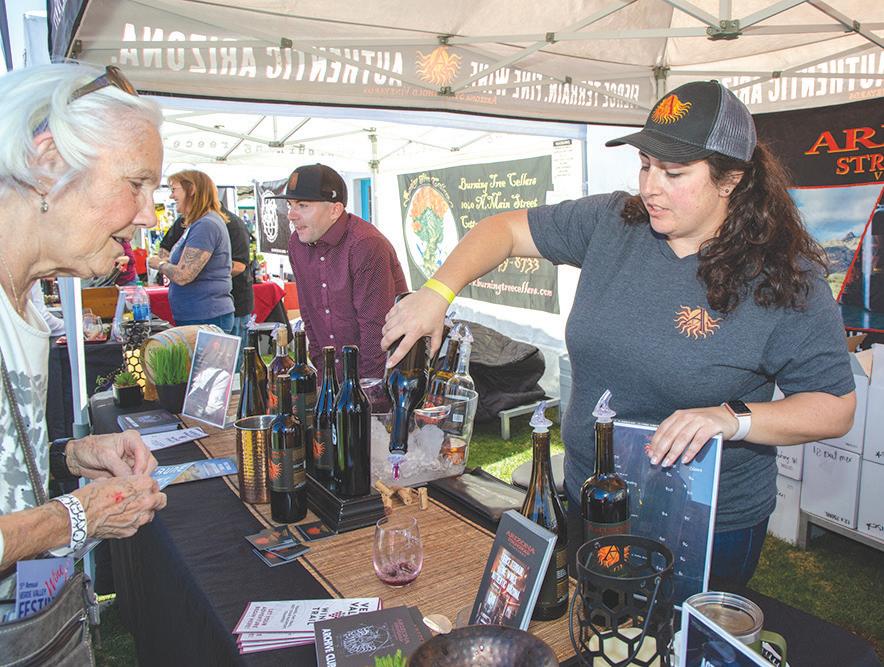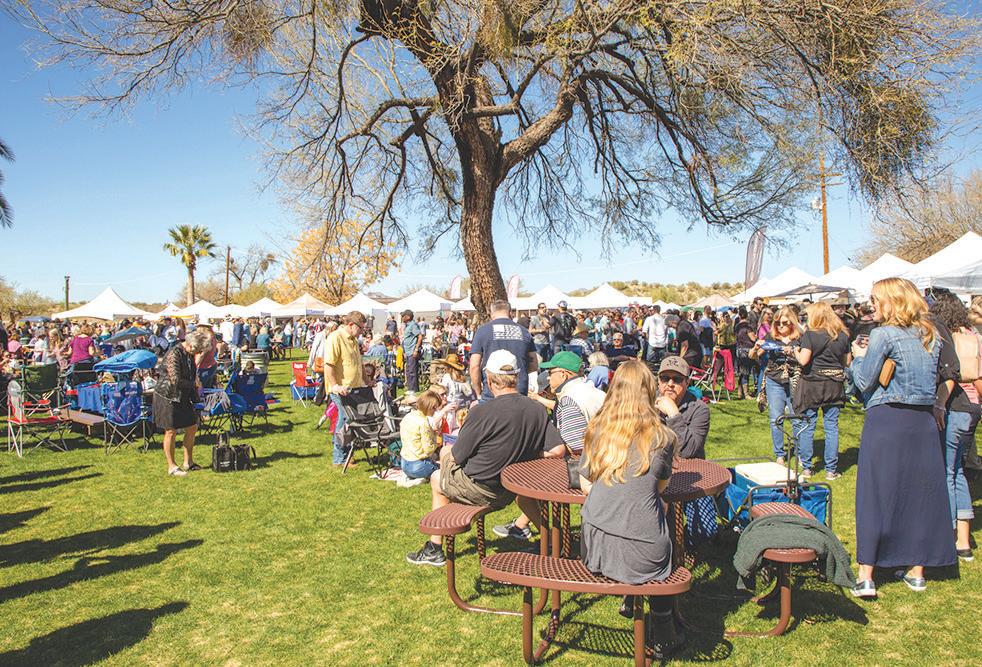
5 minute read
Off the Vine
25 wineries to showcase products from their cellars
BY GERI KOEPPEL
The Arizona wine industry has evolved greatly in the past couple of decades, bringing dozens of new vintners and a blossoming of wine varietals and styles.
An ideal way to experience the current crop of off erings is at the Off the Vine Arizona Wine Festival on Saturday, February 19, at historic Steam Pump Ranch in Oro Valley.
The festival will showcase 25 of the state’s 120-plus wineries, with each bringing several wines from their cellars. “Orange wines; canned sparkling wines; dry, dusty, fruit-forward reds; unique, fresh, aromatic whites — they can really explore the terroir of Arizona,” says Kris Pothier, president of the Arizona Wine Growers Association and co-owner of Chateau Tumbleweed.
The wine tasting will be set up in tents and attendees can meet winemakers, so come with questions, Pothier notes. Picnic tables are abundant, as are treats from food trucks and an adjacent farmers market.
“I go to a lot of festivals, and this is by far my favorite place to be pouring wine,” Pothier remarks.
This is thanks to the food, live music and “insanely gorgeous” location, not to mention the array of vintners.
Arizona has three American Viticultural Areas (AVAs), or offi cial grape-growing regions: Sonoita-Elgin, Willcox and the Verde Valley, the latter of which was just federally recognized in November 2021. All three will be represented at the festival, but “78% of the fruit grown in the state is coming from Willcox, so they’re going to be drinking wine that’s from a place about an hour-plus from where they’re standing in Oro Valley,” Pothier says.
All the grapes that are grown here are planted at between 3,500 and 4,500 feet in elevation and really run the gamut, according to Pothier. “There are not a lot of varietals that don’t grow in Arizona,” she notes.
Wine regions typically bring to mind a certain type and style of grape. Napa Valley, California, is known for big, bold cabernet sauvignon. Willamette Valley, Oregon, is home to elegant pinot noir.
Pothier says the defi ning quality of Arizona wines is its wide swath of terroir and style. That’s exciting for growers and drinkers.
In the early 2000s, several growers were big on Rhone varietals and blends (mainly grenache, syrah, mourvèdre and viognier), Pothier said, but today’s crop of winemakers is experimenting with grapes such as aglianico, montepulciano and sangiovese.
“These Spanish and Italian varietals at these high elevations with the extreme sun retain their acidity in the cellar,” she remarks.
Chateau Tumbleweed, in fact, produces a sangiovese from the Cimarron vineyard in Willcox that was planted in the late 2000s by Dick Erath (of Oregon wine fame) and later sold to Todd and Kelly Bostock of Doz Cabezas WineWorks. Pothier says Arizona is closer than anywhere else in the New World at producing these Old World varietals with the same characteristics as their forebears. An enology instructor at a wine college in Tuscany “thought it was extremely varietally correct, and it was surprising to him because he didn’t know Arizona propagated vines,” she muses.
Another grape that’s gaining attention here is graciano, a beefy, acidic Spanish varietal used in Rioja blends. “In Spain, they fi nd it too aggressive and acidic to bottle alone, but the way it expresses itself in Arizona is fantastic,” Pothier says.
Also, Kent Callaghan, who’s been making wine in Arizona since 1990, is a big proponent of tannat and petit manseng, and many winemakers are using malvasia bianca due to its fl oral nose.
Those earlier days of Arizona wine, even into the 2000s, were tougher than now, Pothier says, because the American palate wasn’t as adventurous. Many casual wine drinkers were conditioned to stick to chardonnay and cabernet sauvignon and wouldn’t order anything they couldn’t pronounce. There also was a stigma that only certain places could produce wine. Today, there are 260 AVAs in 34 states, and Arizona wines have been highly awarded at competitions and well reviewed in major publications.
Over time, too, Pothier notes the snob factor has decreased, which has helped the state’s wine industry fl ourish. Wine isn’t “only for a certain sector of society who’s well traveled” anymore, she says. And many wine labels are fun and whimsical, including those that Pothier illustrates herself for Chateau Tumbleweed.
People are more comfortable being open to new experiences with wine as well. At Off the Vine, Pothier suggests, if you aren’t familiar with some of the grapes and blends and are unsure if you’ll like them, tell the person pouring what you normally enjoy so they can give you something similar.
Not to mention, don’t be shy about asking at the tables for more information about the winemakers and their wares and backgrounds. Most of the wines being poured will be from the 2018-20 vintages, which Pothier says were all good growing years. Bottles will be for sale on site as well.
Stalwart producers such as Callaghan Vineyards, Dos Cabezas WineWorks and Caduceus Cellars will be there along with new upstarts such as Cove Mesa Vineyard, the Oddity Wine Collective and the 100% woman-owned Vino Stache Winery. A full list of participants and all other details are on the festival’s website. “We are a small group of people and we’ve all helped each other through the years, which is lovely, and it’s nice to see us all in one spot,” Pothier says.
Twenty-fi ve of the state’s 120-plus wineries will each bring several wines from their cellars. (Submitted photos) Picnic tables are abudant at the Off the Vine Arizona Wine Festival. Tasting will be set up in tents, and attendees can meet winemakers.


MORE INFO
What: Off the Vine Arizona Wine Festival When: 11 a.m. to 6 p.m. Saturday, February 19 Where: Steam Pump Ranch, 10901 N. Oracle Road, Oro Valley Cost: $35 ($30 for early bird tickets); nondrinkers and children are free Info: off thevineaz.com







